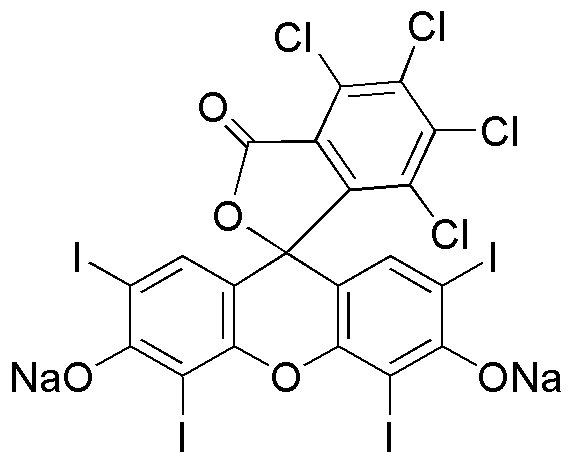Rose Bengal is widely utilized in research focused on:
- Photodynamic Therapy: This compound is effective in treating certain types of cancer by generating reactive oxygen species when exposed to light, helping to target and destroy cancer cells.
- Biological Staining: It is commonly used as a dye in histology and microbiology for staining tissues and cells, allowing for better visualization under a microscope.
- Environmental Monitoring: Rose Bengal serves as a tracer in studies of water pollution, helping researchers track the movement of contaminants in aquatic environments.
- Food Industry: It is used as a food coloring agent, providing a vibrant hue to products while being recognized as safe for consumption in regulated amounts.
- Antimicrobial Applications: The compound exhibits antibacterial properties, making it useful in developing treatments for infections and in preserving various products.
General Information
Properties
Safety and Regulations
Applications
Rose Bengal is widely utilized in research focused on:
- Photodynamic Therapy: This compound is effective in treating certain types of cancer by generating reactive oxygen species when exposed to light, helping to target and destroy cancer cells.
- Biological Staining: It is commonly used as a dye in histology and microbiology for staining tissues and cells, allowing for better visualization under a microscope.
- Environmental Monitoring: Rose Bengal serves as a tracer in studies of water pollution, helping researchers track the movement of contaminants in aquatic environments.
- Food Industry: It is used as a food coloring agent, providing a vibrant hue to products while being recognized as safe for consumption in regulated amounts.
- Antimicrobial Applications: The compound exhibits antibacterial properties, making it useful in developing treatments for infections and in preserving various products.
Documents
Safety Data Sheets (SDS)
The SDS provides comprehensive safety information on handling, storage, and disposal of the product.
Product Specification (PS)
The PS provides a comprehensive breakdown of the product’s properties, including chemical composition, physical state, purity, and storage requirements. It also details acceptable quality ranges and the product's intended applications.
Certificates of Analysis (COA)
Search for Certificates of Analysis (COA) by entering the products Lot Number. Lot and Batch Numbers can be found on a product’s label following the words ‘Lot’ or ‘Batch’.
Número de catálogo
Número de lote/lote
Certificates Of Origin (COO)
This COO confirms the country where the product was manufactured, and also details the materials and components used in it and whether it is derived from natural, synthetic, or other specific sources. This certificate may be required for customs, trade, and regulatory compliance.
Número de catálogo
Número de lote/lote
Safety Data Sheets (SDS)
The SDS provides comprehensive safety information on handling, storage, and disposal of the product.
DownloadProduct Specification (PS)
The PS provides a comprehensive breakdown of the product’s properties, including chemical composition, physical state, purity, and storage requirements. It also details acceptable quality ranges and the product's intended applications.
DownloadCertificates of Analysis (COA)
Search for Certificates of Analysis (COA) by entering the products Lot Number. Lot and Batch Numbers can be found on a product’s label following the words ‘Lot’ or ‘Batch’.
Número de catálogo
Número de lote/lote
Certificates Of Origin (COO)
This COO confirms the country where the product was manufactured, and also details the materials and components used in it and whether it is derived from natural, synthetic, or other specific sources. This certificate may be required for customs, trade, and regulatory compliance.


